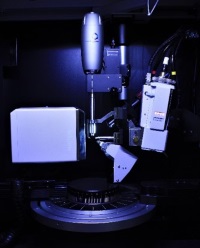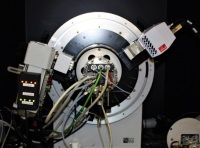Our equipment
Meet our kit! Take your pick from the spectrometers and instruments we have to offer, find out what they do and where they are used in our undergraduate courses.
Nuclear Magnetic Resonance Spectroscopy (NMR)
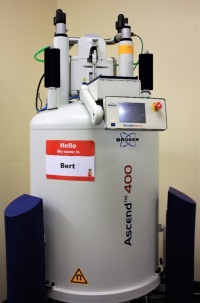
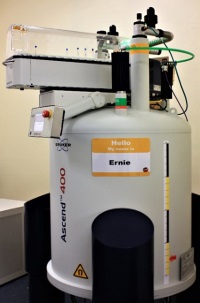
Meet Bert and Ernie!
Our twin 400 MHz NMR spectrometers are used by all years of the chemistry and medicinal chemistry BSc and MChem courses and you will be trained how to use them from Year 1.
NMR is one of the most powerful analytical techniques for discovering the structure of new chemical compounds.
Ernie is the newest of spectrometers, arriving in Spring 2018. Bert is capable of looking at both solid and solution samples and is used a lot in research projects.
X-ray Diffraction (XRD)
The school has 3 X-ray diffractometers.
- Single Crystal – you guessed it, one crystal at time!
- In-situ – for following reactions.
- Powder – for identification of materials.
X-ray diffraction is the way chemists ‘take pictures’ of molecules that are in a solid state.
Used in the Year 2 modules and for research projects in Years 3 and 4.
|
|
|
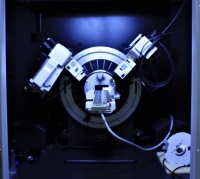
|
| 1 | 2 | 3 |
Quadrupole Time Of Flight Liquid Chromatography Mass Spectrometer (Q-TOF)
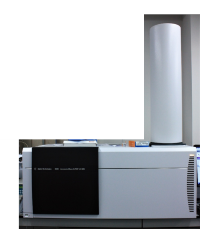
Accurate mass is an essential tool for synthetic chemists. When you make a new molecule you have to find out its structure and the Q-TOF can help you do this by accurately weighing a molecule to 4 decimal places, accurately enough to be able to determine its elemental composition.
How does the Q-TOF work? it literally measures how long it takes from an ion to travel from A to B and that is determined by its mass. The tube sticking up is the flight tube.
Used as part of research projects in Years 3 and 4.
Fourier Transform Infra-red Spectrometry (FT-IR)
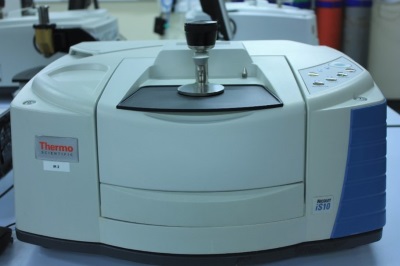
Chemistry is home to 10 Infra-red spectrometers.
This technique is one of the most used characterisation methods in chemistry. Infra-red radiation is absorbed by chemical bonds, making them them vibrate. If we look to see what IR radiation is absorbed, we can determine the bonds within a molecule.
They are used throughout the chemistry, medicinal chemistry courses during Years 1, 2 and 3 and in the research projects.
Inductively Coupled Plasma- Optical Emission Spectrometry (ICP-OES)
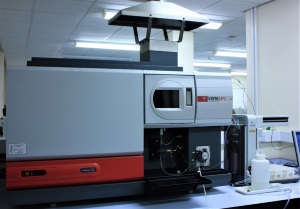
Like a big flame test! (Only at 28,000 °C)
The ICP allows you to identify the ions in a solution and to accurately determine their concentration.
Used as part of the Year 2 modules and for research projects in Years 3 and 4.
Gas Chromatography-Mass Spectrometry (GC-MS)
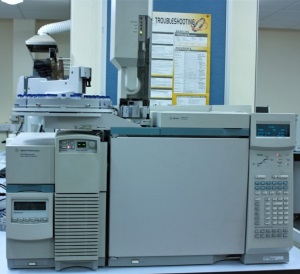
Gas chromatography is an excellent way of separating mixtures of volatile compounds and then mass spectrometry gives you a unique signature for each compound which allows you to identify the structure.
Used as part of the Year 2 modules and for research projects in Years 3 and 4.
Ultraviolet-Visible Spectrometry (UV-Vis)
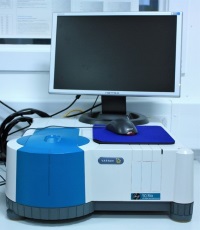
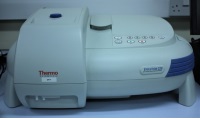
UV-Vis spectroscopy is excellent for following the rate of reactions of molecules that contain chromophores, groups that absorb visible and UV light. You will get to analyse everything from alcopops to sunscreens!
They are extensively used in the chemistry and medicinal chemistry courses in Years 1 and 2 and for research projects in Years 3 and 4.
High-Performance Liquid Chromatography (HPLC)
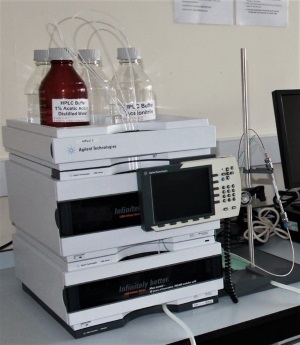
Ever wondered how performance enhancing drugs are detected in athletes?
HPLC is extensively used in drug testing and the Pharmaceutical Industry. It is an excellent method of separating polar organic molecules in an aqueous environment and is one of the most commonly used analytical techniques today.
Used as part of the Year 2 modules and for research projects in Years 3 and 4.
Raman Spectroscopy
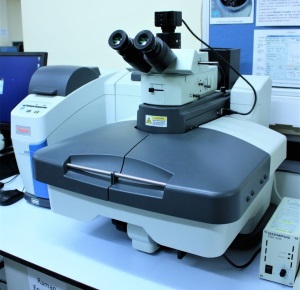
The microscope allows you to identify specific sites on a surface and then you can use the Raman spectrometer to take a spectrum of the surface.
It is used for mapping the surface of materials such as catalysts and supports.
Used as part of the Year 3 modules and in the research projects.
Fluorescence Spectroscopy
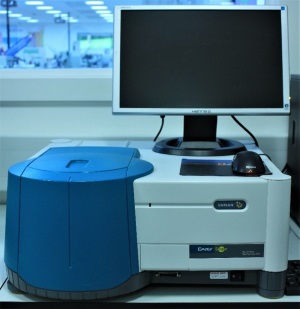
Some molecules absorb radiation at one wavelength and then give it back out at another wavelength. The optical brighteners in washing powders do this to get you the ‘whiter than white ‘ look.
They are used in Years 1 and 2 and in the research projects in Years 3 and 4
Gas Chromatography (GC)
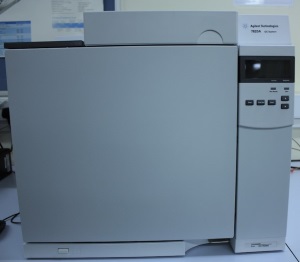
These are used for separating mixtures of volatile compounds such as perfumes, essential oils and petroleum products. The compounds move between a liquid phase and a gas phase and are separated by size – the small molecules move fastest.
Used as part of the Year 2 modules and for research projects in Years 3 and 4.
Elemental Analysis (CHNSO)
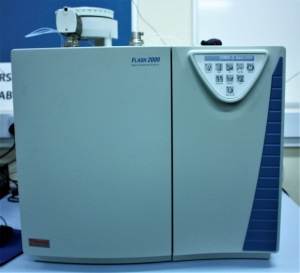
If you want to find out how much carbon, hydrogen or nitrogen is in your compounds then Elemental Analysis is the technique to use. This analytical technique is over 200 years old, and simply involves burning a known amount of a compound in pure oxygen and accurately determining the mass of water, carbon dioxide and nitrogen oxides that are produced.
Used as part of research projects in Year 3 and 4.
School address
Lennard-Jones School of Chemical and Physical Sciences
Lennard-Jones Building
Keele University
Staffordshire
ST5 5BG, UK
Phone (School Office): +44 (0)1782 733033, (Chemistry): +44 (0)1782 731693, (Forensic Science): +44 (0)1782 731694, (Physics): +44 (0)1782 733527
Email: scps@keele.ac.uk
Information for schools and colleges
Programme directors
Chemistry and Medicinal Chemistry
Dr Tess Phillips
Tel : +44 (0)1782 733038
Email : t.r.phillips@keele.ac.uk
Dr Chris Hawes
Tel : +44 (0)1782 732820
Email : c.s.hawes@keele.ac.uk
Forensic Science
Dr Jamie K. Pringle
Tel : +44 (0)1782 733163
Email : j.k.pringle@keele.ac.uk
Physics and Astrophysics
Dr Arumugam Mahendrasingam
Tel : +44 (0)1782 733312
Email : a.mahendrasingam@keele.ac.uk
Admission tutors
Chemistry and Medicinal Chemistry
Dr Natalie Capel
Tel : +44 (0)1782 733584
Email : n.j.capel@keele.ac.uk
Forensic Science
Dr Natalie Capel
Tel : +44 (0)1782 733584
Email : n.j.capel@keele.ac.uk
Physics and Astrophysics
Dr Patrick Connell
Tel : +44 (0)1782 733892
Email : physics@keele.ac.uk or p.j.connell@keele.ac.uk



